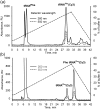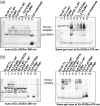Design and properties of efficient tRNA:EF-Tu FRET system for studies of ribosomal translation
- PMID: 23447652
- PMCID: PMC3630515
- DOI: 10.1093/protein/gzt006
Design and properties of efficient tRNA:EF-Tu FRET system for studies of ribosomal translation
Abstract
Formation of the ternary complex between GTP-bound form of elongation factor Tu (EF-Tu) and aminoacylated transfer RNA (aa-tRNA) is a key event in protein biosynthesis. Here we show that fluorescently modified Escherichia coli EF-Tu carrying three mutations, C137A, C255V and E348C, and fluorescently modified Phe-tRNA(Phe) form functionally active ternary complex that has properties similar to those of the naturally occurring (unmodified) complex. Similarities include the binding and binding rate constants, behavior in gel retardation assay, as well as activities in tRNA protection and in vitro translation assays. Proper labeling of EF-Tu was demonstrated in MALDI mass spectroscopy experiments. To generate the mutant EF-Tu, a series of genetic constructions were performed. Two native cysteine residues in the wild-type EF-Tu at positions 137 and 255 were replaced by Ala and Val, respectively, and an additional cysteine was introduced either in position 324 or 348. The assembly FRET assay showed a 5- to 7-fold increase of Cy5-labeled EF-Tu E348C mutant fluorescence upon formation of ternary complex with charged tRNA(Phe)(Cy3-labeled) when the complex was excited at 532 nm and monitored at 665 nm. In a control experiment, we did not observe FRET using uncharged tRNA(Phe)(Cy3), nor with wild-type EF-Tu preparation that was allowed to react with Cy5 maleimide, nor in the absence of GTP. The results obtained demonstrate that the EF-Tu:tRNA FRET system described can be used for investigations of ribosomal translation in many types of experiments.
Figures












Similar articles
-
Labeled EF-Tus for rapid kinetic studies of pretranslocation complex formation.ACS Chem Biol. 2014 Oct 17;9(10):2421-31. doi: 10.1021/cb500409y. Epub 2014 Aug 22. ACS Chem Biol. 2014. PMID: 25126896 Free PMC article.
-
Elongation factor-Tu can repetitively engage aminoacyl-tRNA within the ribosome during the proofreading stage of tRNA selection.Proc Natl Acad Sci U S A. 2020 Feb 18;117(7):3610-3620. doi: 10.1073/pnas.1904469117. Epub 2020 Feb 5. Proc Natl Acad Sci U S A. 2020. PMID: 32024753 Free PMC article.
-
Engineered EF-Tu and tRNA-Based FRET Screening Assay to Find Inhibitors of Protein Synthesis in Bacteria.Assay Drug Dev Technol. 2018 May/Jun;16(4):212-221. doi: 10.1089/adt.2018.843. Epub 2018 Jun 5. Assay Drug Dev Technol. 2018. PMID: 29870274
-
tRNA-ribosome interactions.Biochem Cell Biol. 1995 Nov-Dec;73(11-12):1049-54. doi: 10.1139/o95-112. Biochem Cell Biol. 1995. PMID: 8722020 Review.
-
Elongation factor Tu, a GTPase triggered by codon recognition on the ribosome: mechanism and GTP consumption.Biochem Cell Biol. 1995 Nov-Dec;73(11-12):1221-7. doi: 10.1139/o95-132. Biochem Cell Biol. 1995. PMID: 8722040 Review.
Cited by
-
Hierarchical mechanism of amino acid sensing by the T-box riboswitch.Nat Commun. 2018 May 14;9(1):1896. doi: 10.1038/s41467-018-04305-6. Nat Commun. 2018. PMID: 29760498 Free PMC article.
-
Labeled EF-Tus for rapid kinetic studies of pretranslocation complex formation.ACS Chem Biol. 2014 Oct 17;9(10):2421-31. doi: 10.1021/cb500409y. Epub 2014 Aug 22. ACS Chem Biol. 2014. PMID: 25126896 Free PMC article.
-
Identification of an antibiotic from an HTS targeting EF-Tu:tRNA interaction: a prospective topical treatment for MRSA skin infections.Appl Environ Microbiol. 2025 Jan 31;91(1):e0204624. doi: 10.1128/aem.02046-24. Epub 2024 Dec 23. Appl Environ Microbiol. 2025. PMID: 39714192 Free PMC article.
References
-
- Abrahamson J.K., Laue T.M., Miller D.L., Johnson A.E. Biochemistry. 1985;24:692–700. - PubMed
-
- Arai K., Kawakita M., Nakamura S., Ishikawa K., Kaziro Y. J. Biochem. 1974;76:523–534. - PubMed
-
- Berchtold H., Reshetnikova L., Reiser C.O., Schirmer N.K., Sprinzl M., Hilgenfeld R. Nature. 1993;365:126–132. - PubMed
Publication types
MeSH terms
Substances
Grants and funding
LinkOut - more resources
Full Text Sources
Other Literature Sources

